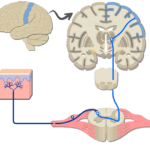

T7-11 located in the middle innervate the body wall and abdominal viscera, while T11-L2(3) located inferiorly innervate the lower limb and pelvic viscera. Basically, the T1-6 cell bodies that are located superiorly innervate the head, upper limb and thoracic viscera. The preganglionic SNS cell bodies are organised somatotopically, meaning the arrangement of the cell bodies is a close representation to that of the body. You can think of the ICLs as longitudinal tubes passing through the respective lateral horns of the spinal cord. This region consists of the visceral motor region of the spinal gray matter. ICLs are part of the lateral horns of the gray matter of the thoracic (T1-12) and upper lumbar (L2 or 元) spinal cord segments, hence the alternative name “thoracolumbar” for the sympathetic division. The cell bodies of the preganglionic neurons of the SNS are found only in the intermediolateral cell columns (ICLs) of the spinal cord, one on the left side and on the right. Lateral grey column of spinal cord, Columna grisea lateralis medullae spinalis The anatomical distinction between the sympathetic and parasympathetic divisions is given by the location of the presynaptic cell bodies and the types of nerves conducting presynaptic nerve fibers.Īutonomic nervous system starter pack is waiting for you in our study unit: It is the balance of the actions of both divisions that maintains a stable internal environment in the body. They usually work antagonistically in the organs but in a well-integrated manner. Functionally, the ANS is divided into sympathetic (SNS) and parasympathetic (PSNS) nervous systems. The ANS can be divided according to its location (central and peripheral parts) and function. skeletal muscle function) and it’s under the direct control of the cerebral cortex.

In contrast, the somatic nervous system mediates voluntary responses of the body (e.g. Together with endocrine glands, the ANS affects important body functions without the direct involvement of the cerebral cortex.

The autonomic nervous system (ANS) is a functional division of the nervous system that controls involuntary actions of muscles, glands and internal organs (e.g. Stress response of the body: increases heart rate, miosis of the eye, vasoconstriction, bronchodilation, energy release from liver, adrenaline release from suprarenal gland Spinal nerves 元-Co carry sympathetic innervation to the cutaneous structures of the lower limbs Spinal nerves T1-L2 carry sympathetic innervation for the trunk wall, as well as participate in comprising the splanchnic nerves for innervation of the abdominopelvic viscera Spinal nerves C2-C8 carry sympathetic innervation to head, neck, upper limbs and thorax The axons of the ganglionic neurons that leave the ganglia in the form of gray rami communicantes which join the rami of the spinal nerves. The neuronal bodies of the sympathetic ganglia synapse with the white rami communicantes Sympathetic trunk (paravertebral ganglia) The axons of the preganglionic neurons that leave the spinal cord through the anterior rami of spinal nerves and continue their path as white rami communicantes Neurons of the intermediolateral column of the spinal cord, found within the levels T1-T12 and L1-元 Thoracolumbar division of the autonomic nervous system which is in charge to initiate bodily stress response (“flight or fight”) Key facts about the sympathetic nervous system This article will discuss the anatomy and function of the sympathetic nervous system. brain and muscles), and increased sweating. Some of these physical effects include faster breathing, increased heart rate and blood pressure, dilation of pupils, redirection of blood flow to important organs (e.g. The sympathetic system activates numerous complex pathways to enable an adequate response to a threat or trauma. While the sympathetic nervous system is also important at rest, it is essential for preparing the body for emergency response in endangering situations, also known as the “fight-or-flight” response. The sympathetic pathway can be divided into three following components: The origin of the sympathetic nervous system is found within the thoracic and lumbar segments of the spinal cord also known as the thoracolumbar division (T1 to L2,3). The sympathetic nervous system is part of the autonomic nervous system, along with its counterpart, parasympathetic nervous system.


 0 kommentar(er)
0 kommentar(er)
